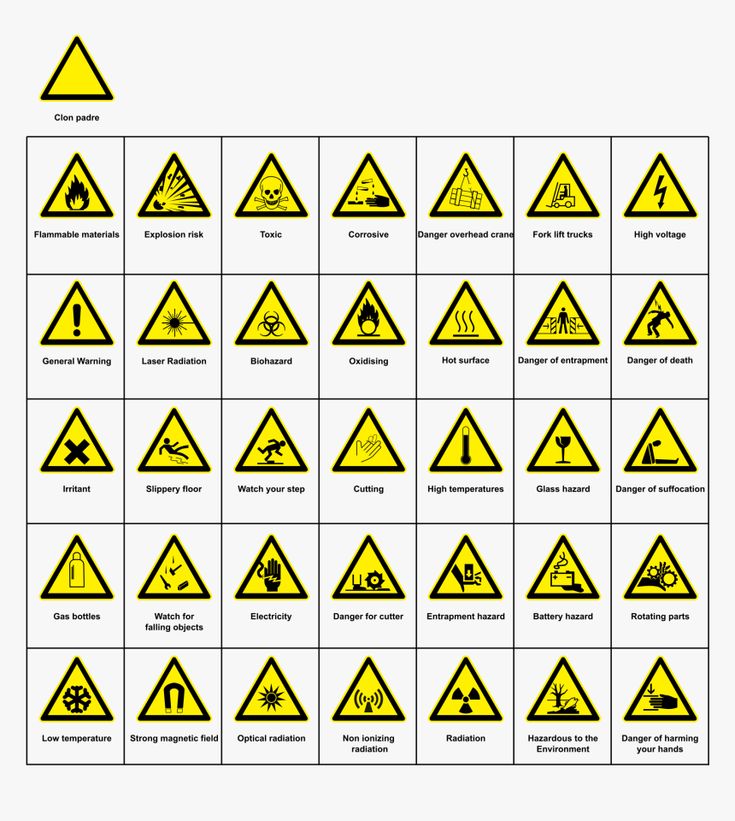Safety Hazard Signs And Symbols

In today's fast-paced and complex work environments, safety is paramount. Ensuring the well-being of employees, visitors, and the general public requires a comprehensive understanding of safety protocols, and a key component of this understanding is the interpretation of safety hazard signs and symbols. These visual cues serve as universal communicators, conveying critical information quickly and effectively, regardless of language barriers.
Understanding the Language of Safety Signs

Safety hazard signs are designed to be easily recognizable and understood by individuals from diverse backgrounds. They use a combination of colors, shapes, and symbols to convey specific messages related to potential hazards, precautions, and emergency procedures. The effectiveness of these signs lies in their ability to provide instant warnings or instructions, even in high-stress situations.
The Importance of Standardization
Standardization is crucial in the world of safety signs. Various international organizations, including the International Organization for Standardization (ISO), have developed guidelines and standards to ensure consistency in sign design and interpretation. These standards help promote a common language of safety, reducing confusion and enhancing overall safety awareness.
For instance, the ISO 7010 standard specifies a collection of safety symbols that are recognized internationally. These symbols, when used in conjunction with appropriate colors and shapes, create a powerful tool for conveying safety messages.
Color Coding for Clarity
Color plays a significant role in safety signage. Different colors are associated with specific types of hazards or instructions. For example, the color red is universally recognized as a warning signal, indicating potential danger or prohibition. On the other hand, green is often used to indicate safe areas or actions.
| Color | Significance |
|---|---|
| Red | Danger, prohibition, and stop |
| Yellow/Amber | Caution and warning |
| Green | Safe condition, proceed, and first aid |
| Blue | Mandatory actions and information |

Shapes and Symbols: A Universal Language
Shapes and symbols further enhance the clarity of safety signs. Triangles, circles, and squares, when combined with specific symbols, convey distinct messages. For example, a triangle often signifies caution or warning, while a circle with a diagonal line through it indicates prohibition.
| Shape | Symbol | Meaning |
|---|---|---|
| Triangle | Exclamation mark | Caution |
| Circle | Diagonal line | Prohibition |
| Square | First aid cross | Medical assistance |
| Rectangle | Arrow | Mandatory action |
Types of Safety Hazard Signs

Safety hazard signs can be categorized into several types, each serving a unique purpose:
1. Warning Signs
Warning signs are designed to alert individuals to potential hazards or dangerous conditions. They typically feature a yellow or amber background with black symbols or text. These signs are crucial in preventing accidents and injuries by providing advanced warning.
2. Prohibition Signs
Prohibition signs indicate actions or behaviors that are strictly forbidden. They often feature a circular shape with a diagonal line across it, indicating a prohibition symbol. The background is usually red, making these signs easily recognizable. Prohibition signs ensure compliance with safety regulations and prevent hazardous situations.
3. Mandatory Signs
Mandatory signs provide instructions or indicate actions that must be taken. They feature a blue circle with a white symbol or text, clearly indicating the required action. These signs are essential for ensuring proper safety procedures are followed.
4. Emergency Information Signs
Emergency information signs provide critical details during emergency situations. They offer guidance on evacuation routes, assembly points, and first aid locations. These signs are typically green, with white symbols or text, ensuring they stand out during high-stress situations.
5. Fire Safety Signs
Fire safety signs are a vital component of any safety plan. They provide information on fire prevention, fire equipment locations, and evacuation procedures. These signs often feature a red background with white symbols or text, ensuring they are easily noticed in an emergency.
Real-World Applications and Best Practices
Effective safety hazard signage is not just about the design; it’s about proper placement and maintenance as well. Signs should be strategically located where they can be easily seen and understood by all individuals, regardless of their position or angle of view. Regular inspections and updates are essential to ensure signs remain legible and accurate.
Case Study: Effective Signage in Industrial Settings
In an industrial environment, safety hazard signs play a crucial role in preventing accidents. For instance, a chemical manufacturing plant might utilize signs to indicate the presence of flammable materials, the location of fire extinguishers, and the proper procedures for handling hazardous substances. These signs, when properly designed and placed, can significantly reduce the risk of accidents and ensure a safer work environment.
Ensuring Sign Legibility
To ensure signs are easily understood, it’s essential to consider factors such as lighting, contrast, and font size. Signs should be illuminated or reflective to ensure visibility in low-light conditions. Additionally, the use of high-contrast colors and clear, simple symbols can greatly enhance sign legibility.
Regular Sign Audits
Conducting regular audits of safety signs is crucial to maintaining an effective safety culture. These audits should involve checking for sign damage, ensuring signs are up-to-date with current regulations, and verifying their placement and visibility. By conducting regular audits, organizations can identify areas for improvement and ensure compliance with safety standards.
Future Trends in Safety Signage
As technology advances, so does the world of safety signage. The development of digital signage systems offers new opportunities for dynamic and interactive safety communications. These systems can provide real-time updates, ensuring that safety information is always current and relevant.
Additionally, the integration of augmented reality (AR) and virtual reality (VR) technologies into safety training and signage is gaining traction. These technologies offer immersive experiences, allowing individuals to practice safety procedures and better understand potential hazards in a safe, controlled environment.
The Role of AI in Safety Signage
Artificial Intelligence (AI) is also making its mark on safety signage. AI-powered systems can analyze data from various sensors and cameras to detect potential hazards and automatically update signage accordingly. This real-time hazard detection and communication can greatly enhance workplace safety.
Conclusion

Safety hazard signs and symbols are an essential component of any safety program. They provide a universal language that transcends linguistic barriers, ensuring everyone understands the potential risks and necessary precautions. By adhering to standardized guidelines and best practices, organizations can create a safer environment for all.
As technology continues to advance, the future of safety signage looks promising. From digital and interactive systems to AI-powered hazard detection, safety signage is evolving to meet the challenges of modern work environments. By embracing these advancements and maintaining a commitment to safety, organizations can create a culture of awareness and prevention.
What are the key colors used in safety hazard signs and what do they represent?
+The key colors used in safety hazard signs are red, yellow/amber, green, and blue. Red signifies danger, prohibition, and stop. Yellow/amber is used for caution and warning. Green indicates safe condition, proceed, and first aid. Blue represents mandatory actions and information.
What are the different types of safety hazard signs, and what do they signify?
+There are several types of safety hazard signs, including warning signs (alerting to potential hazards), prohibition signs (indicating forbidden actions), mandatory signs (providing instructions), emergency information signs (guiding during emergencies), and fire safety signs (providing fire-related information).
How can organizations ensure the effectiveness of their safety hazard signs?
+Organizations can ensure the effectiveness of their safety hazard signs by adhering to standardized guidelines, strategically placing signs for maximum visibility, conducting regular sign audits, and keeping signs up-to-date with current regulations. Additionally, ensuring sign legibility through proper lighting, contrast, and font size is crucial.



